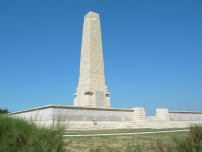| First Name: | Allan William | Last Name: | RICHARDSON | |
|---|---|---|---|---|
| Date of Death: | 11/08/1915 | Lived/Born In: | Chalk Farm | |
| Rank: | Lieutenant | Unit: | Royal Irish Rifles6 | |
| Memorial Site: | 1. Chalk Farm, St Saviour 2. Helles Memorial, Gallipoli | |||
Current Information:Gallipoli 1915 On 25 April, British, Australian and New Zealand forces landed on the Gallipoli peninsula. The plan was that these forces would soon defeat a demoralised Turkish army, knock Turkey out of the war, open up the Mediterranean to the Russian navy and threaten Austro-Hungary from the south. None of these things were achieved despite nine months of hard fighting in terrible conditions. It was a heroic failure. By July, 1915, and after much fierce fighting, stalemate had set in at Gallipoli both at Cape Helles where the British and French had landed and at Anzac Cove where the Australian and New Zealand Corps were unable to break out of their beach head. Fresh troops were needed and they were on their way in the shape of four divisions from Britain and things were put on hold until they arrived. The plan for August was for a landing at Suvla Bay to the north of Anzac Cove whilst at the same time, the ANZAC Corps, reinforced by some of the new British troops would effect a breakout from Anzac Cove and establish a line across the peninsula. Whilst this was going on the troops in the south at Helles would stage a number of diversionary attacks. But it all went horribly wrong and much of the reason for this can be explained by inadequate planning and leadership. Nobody seemed to know what they were supposed to be doing and Lieutenant-General Stopford, in charge of the Suvla landings was particularly out of his depth. The landings at Suvla failed to link up with the forces at Anzac and the breakout from there did not happen despite valiant efforts by all concerned. The loss of life on all fronts was again enormous. L.A. Carlyon’s excellent book “Gallipoli” gives a superb yet chilling account of the events. While two brigades from the 10th Division landed at Suvla Bay on 6th August, 29 Brigade, which included the 6th Royal Irish Rifles battalion, landed that morning at Anzac Cove and became part of the force attempting the breakout from there. That night they joined the long column that made its way northwards along the beach before turning inland to tackle the Sari Bair range. Due to a number of problems such as the tiredness of the troops, the difficulty of the terrain and the lack of maps, the advance here was very slow and disjointed and this allowed the enemy to take up strong defensive positions. 6th Royal Irish Rifles spent much of 7th and 8th August trying to orientate themselves in the maze of ridges and gullies that were a feature of the landscape here and it was not until the evening of 9th August that they were part of a mixed force of various intermingled battalions in a position near the Farm, to the north of Rhododendron Spur. The Turks launched a very strong attack at 4.30am on 10th August and after an hour of heavy fighting the battalion fell back to a support line having sustained many casualties. One of these was Allan Richardson. |
||||
| « Back to Search Results | ||||
| If you think any of the information shown here is incorrect, Click Here to submit your amends and comments | ||||




